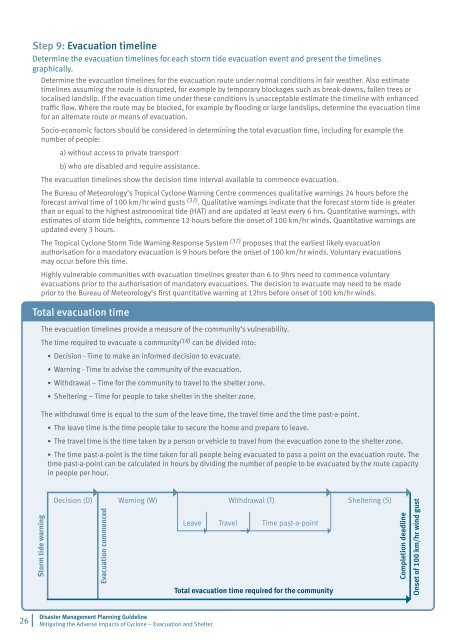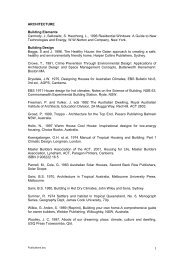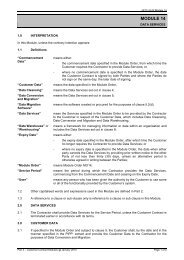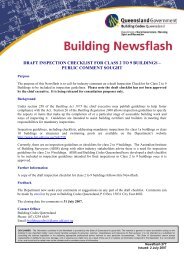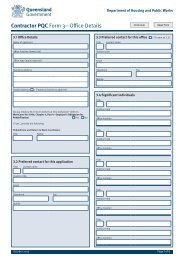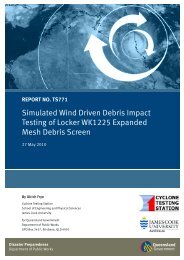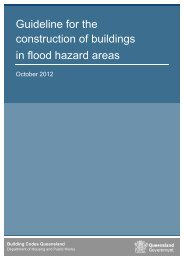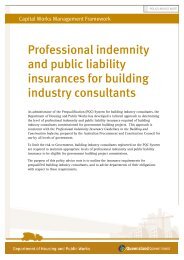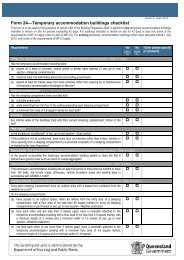Guideline - Department of Housing and Public Works - Queensland ...
Guideline - Department of Housing and Public Works - Queensland ...
Guideline - Department of Housing and Public Works - Queensland ...
You also want an ePaper? Increase the reach of your titles
YUMPU automatically turns print PDFs into web optimized ePapers that Google loves.
Step 9: Evacuation timeline<br />
Determine the evacuation timelines for each storm tide evacuation event <strong>and</strong> present the timelines<br />
graphically.<br />
Determine the evacuation timelines for the evacuation route under normal conditions in fair weather. Also estimate<br />
timelines assuming the route is disrupted, for example by temporary blockages such as break-downs, fallen trees or<br />
localised l<strong>and</strong>slip. If the evacuation time under these conditions is unacceptable estimate the timeline with enhanced<br />
traffic flow. Where the route may be blocked, for example by flooding or large l<strong>and</strong>slips, determine the evacuation time<br />
for an alternate route or means <strong>of</strong> evacuation.<br />
Socio-economic factors should be considered in determining the total evacuation time, including for example the<br />
number <strong>of</strong> people:<br />
a) without access to private transport<br />
b) who are disabled <strong>and</strong> require assistance.<br />
The evacuation timelines show the decision time interval available to commence evacuation.<br />
The Bureau <strong>of</strong> Meteorology’s Tropical Cyclone Warning Centre commences qualitative warnings 24 hours before the<br />
forecast arrival time <strong>of</strong> 100 km/hr wind gusts (37) . Qualitative warnings indicate that the forecast storm tide is greater<br />
than or equal to the highest astronomical tide (HAT) <strong>and</strong> are updated at least every 6 hrs. Quantitative warnings, with<br />
estimates <strong>of</strong> storm tide heights, commence 12 hours before the onset <strong>of</strong> 100 km/hr winds. Quantitative warnings are<br />
updated every 3 hours.<br />
The Tropical Cyclone Storm Tide Warning-Response System (37) proposes that the earliest likely evacuation<br />
authorisation for a m<strong>and</strong>atory evacuation is 9 hours before the onset <strong>of</strong> 100 km/hr winds. Voluntary evacuations<br />
may occur before this time.<br />
Highly vulnerable communities with evacuation timelines greater than 6 to 9hrs need to commence voluntary<br />
evacuations prior to the authorisation <strong>of</strong> m<strong>and</strong>atory evacuations. The decision to evacuate may need to be made<br />
prior to the Bureau <strong>of</strong> Meteorology’s first quantitative warning at 12hrs before onset <strong>of</strong> 100 km/hr winds.<br />
Total evacuation time<br />
The evacuation timelines provide a measure <strong>of</strong> the community’s vulnerability.<br />
The time required to evacuate a community (18) can be divided into:<br />
• Decision - Time to make an informed decision to evacuate.<br />
• Warning - Time to advise the community <strong>of</strong> the evacuation.<br />
• Withdrawal – Time for the community to travel to the shelter zone.<br />
• Sheltering – Time for people to take shelter in the shelter zone.<br />
The withdrawal time is equal to the sum <strong>of</strong> the leave time, the travel time <strong>and</strong> the time past-a-point.<br />
• The leave time is the time people take to secure the home <strong>and</strong> prepare to leave.<br />
• The travel time is the time taken by a person or vehicle to travel from the evacuation zone to the shelter zone.<br />
• The time past-a-point is the time taken for all people being evacuated to pass a point on the evacuation route. The<br />
time past-a-point can be calculated in hours by dividing the number <strong>of</strong> people to be evacuated by the route capacity<br />
in people per hour.<br />
Storm tide warning<br />
Decision (D)<br />
Evacuation commenced<br />
Warning (W)<br />
Withdrawal (T)<br />
Leave Travel Time past-a-point<br />
Total evacuation time required for the community<br />
Sheltering (S)<br />
Completion deadline<br />
Onset <strong>of</strong> 100 km/hr wind gust<br />
26 |<br />
Disaster Management Planning <strong>Guideline</strong><br />
Mitigating the Adverse Impacts <strong>of</strong> Cyclone – Evacuation <strong>and</strong> Shelter


